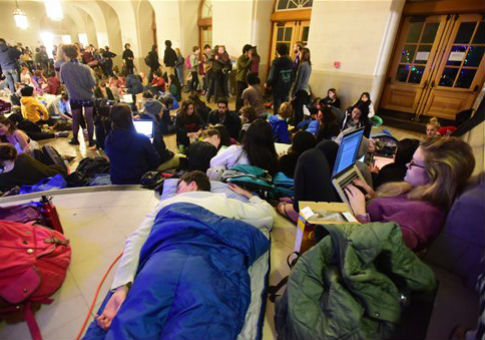As a college student, I have seen firsthand the extent of liberal influence on my campus, from students’ obsession with Bernie Sanders, to not-so-subtle activist professors, all the way to the university president posing for a "hands up, don’t shoot" picture with Black Lives Matter protesters.
In their book Passing on the Right, Jon A. Shields and Joshua M. Dunn, Sr. examine the state of the campus from their positions as conservative professors at Claremont McKenna College and the University of Colorado at Colorado Springs, respectively. They answer important questions about what political conformity on campus means for students, professors, and scholarly discourse as a whole.
Instead of simply presenting statistics and conclusions, the two professors interviewed more than 150 conservative professors from a variety of universities, so the reader hears it straight from the horse’s mouth—or elephant’s mouth, so to speak. These interviews yield some expected findings, but also yield some unexpected findings that should give conservatives hope—for example, many conservatives stated that they felt quite at home, even on predominately liberal campuses.
In fields that are more quantitative and data-driven, such as political science, economics, and business, conservative professors get along more or less amicably with liberal professors because of a shared interest in methodology, which serves as intellectual rules of the road. Some asserted that the politicization of conclusions from academic studies mostly occurs outside of the university, not within it.
The book discusses three ways that conservative professors deal with being a political minority: assimilation, evasion, and combat. A majority use the assimilative approach, internalizing their views and refraining from confrontation; professors said this approach works most of the time, and helps to foster a positive work environment. But sometimes more desperate measures are called for: some professors reported dealing with their colleagues more frankly and openly.
Conservative professors’ concerns had less to do with the faculty lounge than the peer-review panel. The authors discuss how confirmation bias likely skews results in research, because liberals are naturally sympathetic to liberal interpretations of research, while they are skeptical about conservative interpretations. Research that is published is likely to lean liberal, then, with two negative effects for conservatives: first, findings useful to liberal causes are more often promoted by journals and university PR operations, which impacts media coverage and public policy; second, qualified conservative professors may find it difficult to publish—a major disadvantage in a profession where the unofficial slogan is "publish or perish." While the interviewed professors did not believe there was a conspiracy against them, they did believe that subconscious confirmation bias played a part in limiting their numbers and influence.
The authors express concern that the lack of intellectual diversity on faculties and in journals means that students are not exposed to both sides as often as they should be. However, they reject the notion that there is mass indoctrination going on at universities. They note that many individuals first encounter conservatism at college, so having a few years to focus on their education allows them to amass knowledge and refine their beliefs, even if they are only helped by a few sympathetic professors or classmates. The authors also point out that students who enter college as conservatives are often reinforced in their beliefs when they confront the extreme forms of progressivism so common on campus.
Passing on the Right is a worthwhile read for current or prospective college students who are wary of the modern university, but it is vital for those who are considering a career in academics—the authors interviewed older, established professors as well as some new professors, so viewpoints from professors at every stage of their careers are represented.
The authors’ conclusion offers a glimmer of hope for conservatives who are accustomed to grim news and defeatist rhetoric about the state of the campus. Regardless of the challenges, the unspoken bias, and the stigma, "conservatives can survive and even thrive in the liberal university."
